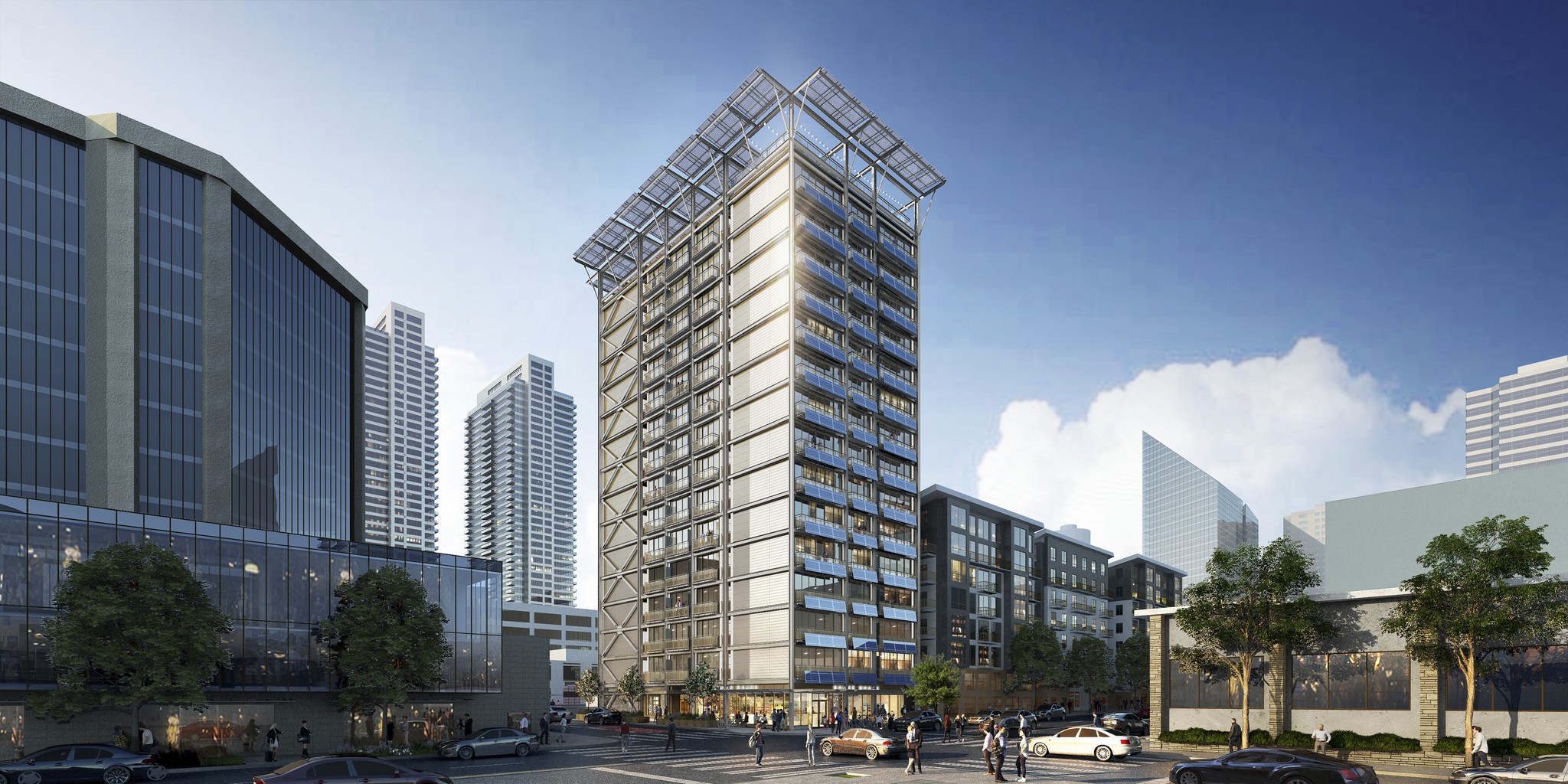Artist’s impression of the 303 Battery, believed to be the world’s first net zero energy home, being built in Seattle’s Belltown neighborhood by Sustainable Living Innovations. (SLI image)
Sustainable Living Innovations, a Seattle-based technology company that has created a new way of building commercial structures, on Thursday laid the foundation stone for a 15-story building that is believed to be the world’s first “net zero energy” high-rise residential building .
The 112-unit building runs on solar power and batteries and includes 27 affordable apartments. It is constructed to a patented design that uses panels manufactured in a Tacoma, Washington facility that are pre-installed with electrical wiring, plumbing, and mechanical equipment.
The design is characterized by underfloor heating and floor-to-ceiling glass walls. It saves water by catching rainfall and recycling gray water from sinks and showers. The approach avoids wasteful, mold-prone materials such as paint, carpeting and drywall.
The address of the site in the Belltown district also fits the green theme: 303 Battery.
 Arlan Collins, CEO of Sustainable Living Innovations. (SLI photo)
Arlan Collins, CEO of Sustainable Living Innovations. (SLI photo)
While the building was supposed to be built and ready to move into next summer, the effort to get here had taken more than 12 years, said Arlan Collins, CEO of Sustainable Living Innovations.
In short, it took Collins and his partner Mark Woerman to develop a whole new way of building.
“The path to this type of environmental performance was to start from scratch, how it works, how it fits together, and what it is supposed to accomplish,” said Collins.
The energy-smart skyscrapers cost less than a traditionally built structure in Seattle, Collins said. Much of the savings comes from using the modular panels which allow for faster construction. The 303 Battery building will use 900 panels of 10 primary panel types. Collins did not provide exact figures on the cost.
Sustainable Living Solutions also builds five- to seven-story mid-height buildings that cost more than comparable, conventionally built buildings. However, some of these costs can be recouped through energy savings.
Seattle Mayor Jenny Durkan and King County Executive Dow Constantine were there on Thursday to celebrate the new development.
“As a city, we must do everything we can to invest in innovative solutions that reduce our dependence on fossil fuels. The 303 Battery building is at the forefront of green design and construction, helping us meet Seattle’s climate goals and create a healthier city while addressing our affordable housing crisis, ”Durkan said in a statement.
 Solar panels on the roof, exterior walls and balconies of 303 Battery will generate electricity for the residents of the Sustainable Living Innovations building. (SLI image)
Solar panels on the roof, exterior walls and balconies of 303 Battery will generate electricity for the residents of the Sustainable Living Innovations building. (SLI image)
The building is certified by the International Living Futures Institute, which has awarded the Bullitt Center in Seattle – a global leader in sustainable buildings – its eco-bona fides certification.
To generate as much energy as it consumes, 303 Battery will include solar panels on the roof, exterior walls and balconies. A bank of lithium batteries will be placed in the basement to store electricity that can be used at night and when solar power is not available. The building incorporates various smart technologies such as sensors for setting thermostats and lighting to save energy.
 One of the construction panels built at Sustainable Living Innovations’ Tacoma manufacturing facility. (SLI image)
One of the construction panels built at Sustainable Living Innovations’ Tacoma manufacturing facility. (SLI image)
In 2014, Sustainable Living Innovations partnered with Intellectual Ventures, the patent holding and technology development company founded by Nathan Myrvold, to obtain patent protection for its design approach.
Sustainable Living Innovations has four more projects planned for Seattle. Two are being built in partnership with the Seattle City Office of Housing and will provide “permanent supportive housing” that combines affordable housing with support services for people struggling with homelessness. Two other projects will include a significant number of affordable units.
The company previously completed a six-story, 24-unit apartment building in the Seattle University District called 47 + 7 Apartments. It uses 70% less energy than a similar room.
In addition to its efforts to promote the environment and the affordability of housing, the company also recruits workers at its manufacturing site who may have difficulty finding employment, including military veterans, homeless people, and those previously incarcerated.
